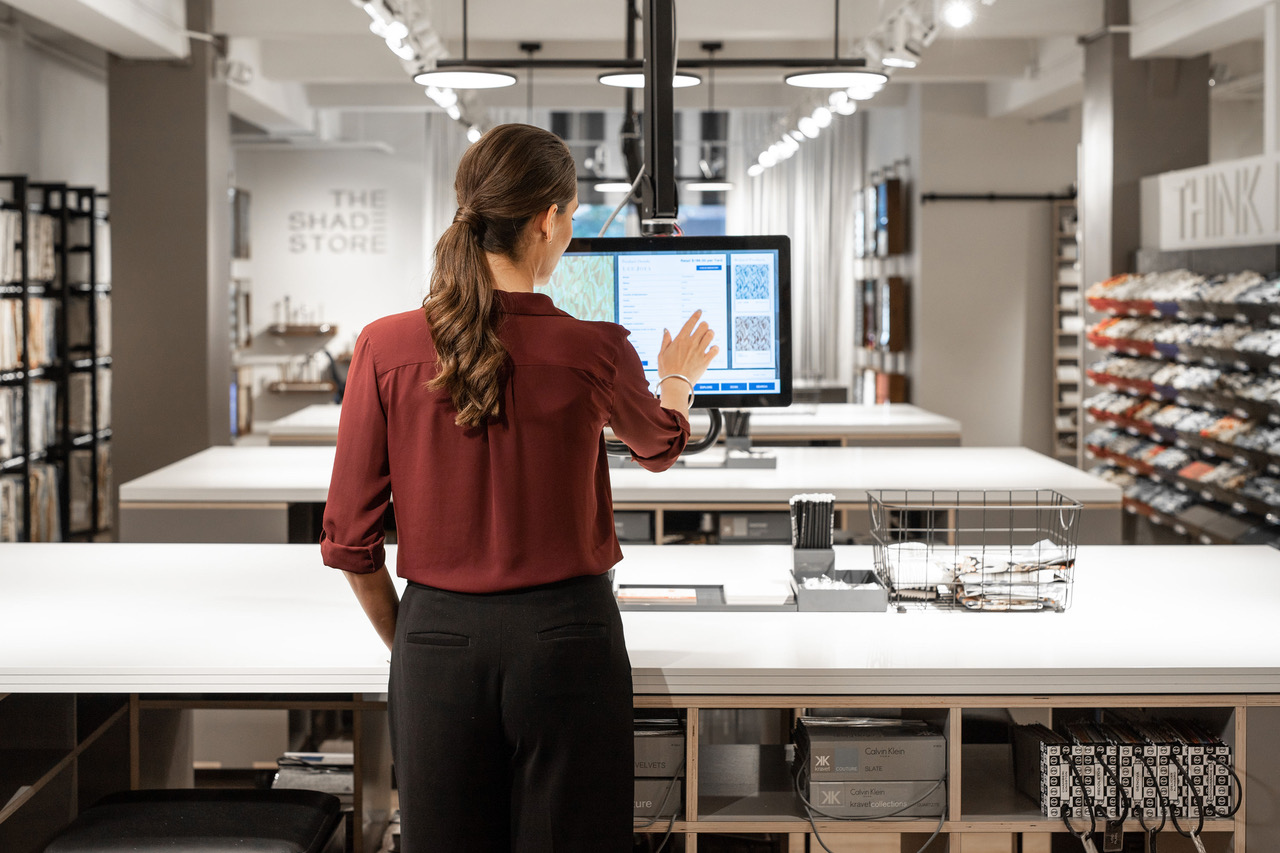The days of seemingly randomly positioned single-unit displays scrolling through still imagery to push in-store promotions and drive customer engagement may not be over, but in the 2020s, only a very brave retailer would rely solely on what is now rightly considered a modest AV tech solution.
Today’s retail spaces have to engage effectively with customers, with AV technology helping to drive in-store purchases and encourage repeat visits. But stores now have to go beyond merely shaping individual in-store customer experiences through AV. They need to deploy the tech in strategic ways that will shape the future of bricks-and-mortar retail, incorporating online purchasing into a more dynamic, touch-before-you-buy in-store experience. Digital signage still has a huge part to play, of course.

“No longer are retailers just putting up a display and throwing pictures on it; rather, they are creating targeted messaging that will increase sales,” said Brian McClimans, vice president of sales, Americas and APAC, at Peerless-AV.
“The most impactful way that AV is currently being used in retail is to create a feeling through digital signage. With this, retailers are focused on the experiential aspects of digital signage … working to deliver a message and a feeling to customers.”
With the internet and the increased popularity of home delivery shaping consumer choices, actually walking into a store has become more of a conscious choice, as opposed to a necessity—so that in-store experience better be worth it!

“This is a radical departure from the last 75 years of retail, where shoppers were forced to visit stores if they wanted to buy goods,” said Laura Davis-Taylor, chief strategy officer, InReality.
“One of the most important takeaways for retailers moving into the next decade is that if they want people to continue coming into their stores, they have to stand apart. The store is the only engagement channel that is truly multisensory, and that means it has the ability to be emotionally compelling.”
“AV technology is making the in-store experience much more intuitive, and serves as the driving force behind bringing the same level of intuitiveness customers are accustomed to when shopping online,” added Alex Peras, manager, product management DigitalMedia, Crestron. “Digital signage, video, and audio are all used to re-create the high-tech [online] experience customers are used to.”
[Innisfree Implements Interactive Signage to Connect with Customers]
Of course, technology is a powerful tool for retailers beyond merely attracting customers. When it comes to the choice of technology, the big focus is on ROI and selecting solutions for maximum impact. By deploying AV tech throughout a store, retailers can learn about customer interests, habits, and preferences, to help deliver a seamless shopping experience.
“AV-based solutions including digital signage, kiosks, computer vision, and artificial intelligence help retailers track and understand the customer journey from the moment they enter the store until they leave,” explained Peras. “This allows retailers to collect powerful data that can be used to ensure that their storefronts are appealing and attractive to new and loyal shoppers.”
Retailers are also using AV for visual tracking of important analytical data—shopping habits and trends, and product popularity—which produces important intel on best-sell goods, helping to increase retail ROI. However, many retailers still measure store success through sales per square foot rather than utilizing the data to its full capacity.
“Too many have rich data tracking models that go into a black hole when it comes to understanding shopper behaviors, feelings, and responses to their in-store engagement points,” said Davis-Taylor. “We have to unify the data connections to have a clear, full view of what’s really happening, versus what we think is happening—and the store is one of the most critical points to do this in, if not the most critical.”
Online retail casts a long shadow over bricks-and-mortar, but it has certainly altered the way retailers regard the shopping experience. AV is increasingly viewed as a holistic, strategic technology, essential to dovetailing online and physical retail. This omnichannel approach is having a huge influence on the retail sector and the technology deployed within it.
“Omnichannel retail plays a significant role in the way technology is deployed in stores,” agreed McClimans. “For many consumers, the online shopping experience has become stronger than retail … and has most certainly impacted the in-store experience.”
The transformed in-store visit involves offering increasingly engaging experiences for consumers, including the deployment of augmented reality/virtual reality (AR/VR) tech that enables them to virtually experience products as they might on their PC at home—even though the products are there in store to touch.
“One thing about in-store shopping that still reigns supreme for retailers is the discovery process for consumers,” added McClimans. “When in a retail store, consumers are able to walk around and find new products they may be interested in.”
Stores today are all about providing their customers with opportunities to experience the brand and uniquely interact with product. It’s an experience-first mentality that is putting technology front and center within the store.

“One of the best examples I could point to today to emphasize the impact of omnichannel on retail is Primark,” said Bryan Meszaros, CEO and founder of OpenEye Global and past president of the Society for Experiential Graphic Designs (SEGD). “They operate a non-transactional website that only showcases their clothing and specifically encourages the shopper to head to the store to purchase.”
This is where the use of numerous LED displays comes into play: to engage customers by creatively merchandising the products they have seen online. It’s old-school, but working alongside online marketing, it’s also incredibly effective—and it’s what consumers want: the omnichannel retail experience made physical.
“Today’s consumers want to engage with brands and stores on their terms, whether online or in-store,” explained John Moezzi, national account manager, NEC Display Solutions of America. “In-store technology that facilitates the seamless movement between channels is vital to finalizing a transaction, whether in-store or online.”
Technology continues to disrupt retail, with new AV in-store additions looking to further cement omnichannel as the way forward for retail, while making bricks-and-mortar even more attractive to consumers, and also improving ROI for retailers.
“What brick-and-mortar has lacked until now is the ability to deliver relevant advertising and accurately measure content performance, including the impact displays have on sales,” added Kelly Harlin, analytics platform strategist, NEC Display Solutions of America. “Anonymous facial detection technology delivers an advantage traditionally reserved for ecommerce, and the business intelligence it delivers to retail will be a big story in the coming years. Sensor technology and data endpoints are becoming more accessible and will have the ability to gather a wide variety of customer behavior and interaction data.”
More obviously for consumers, experiential tech will continue to proliferate, with “experience retail” the buzzword as we move forward into the 2020s.
“It’s all about the theatrics that a consumer experiences when they enter a store,” said Meszaros. “How they interact with a product, how they are able to have a more personalized and tailored experience.”
Meszaros sees projection and touch sensor technology as crucial to the broadening of customer experiences, with the former undergoing something of resurgence in AV due to technological developments, and the latter dovetailing with consumers’ day-to-day interaction with their own devices.
“It’s interesting to see how some display manufacturers have started to introduce displays that use haptic touch, which can create a more ‘lifelike’ scenario for a customer interacting with a display,” he said.
“Capacitive sensors are also interesting because I believe we are shifting to creating unique tactile experiences,” Meszaros added. “A consumer could touch a particular item, which in turn could make an action take place on a display.”
What About Audio?
Audio is an increasingly important part of the in-store shopping experience, adding greatly to the customer’s user experience, adding further emotional stimulus to complement the visual ones. Common monitoring and management systems allow control of the technology in various locations, helping retailers maintain a consistent brand identity as customers travel to different locations.
“Audio helps to evoke emotion and create a unique vibe within an environment,” said Meszaros. “Some retailers understand the importance of a full sensory experience, especially the balance between dynamic visuals and audio to help emphasize the tone of the brand.”
“Audio is definitely a challenge for retailers, but also a very important factor, as it can affect the customer experience greatly,” added McClimans. “The type of audio played helps to create the mood of that store. If the wrong audio is selected, it can inadvertently push people out of the store.”
It is therefore crucial that retailers know the demographic of their customers, and select the audio that appeals to both the brand and the consumer. Audio triggers powerful memories, thoughts, and feelings; used correctly, it can be a huge benefit to business. However, it’s important that customer data is analyzed to ensure that the sound is having a positive impact.
Davis-Taylor noted, “To beat the insights drum again, you have to know how shoppers are feeling (or not feeling!) if you are going to successfully address how audio can play into a better experience.”
